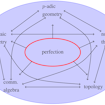Eero Simoncelli Leads New Center for Computational Neuroscience

The Simons Foundation is delighted to announce the launch of the Center for Computational Neuroscience (CCN) within the foundation’s Flatiron Institute in New York City. The new center, led by computational neuroscientist Eero Simoncelli, will use and develop computational models to understand how brains work. The CCN joins existing Flatiron Institute centers devoted to computational problems in astrophysics, biology, mathematics and quantum physics.
Uncovering the inner workings of brains remains one of the greatest scientific frontiers, says Simoncelli, who is also the Silver professor of neural science, mathematics, data science and psychology at New York University. “Now is an especially ripe time for computational neuroscience,” he says. “There are amazing opportunities that were not really possible 20 or even 10 years ago.”
New experimental techniques have generated colossal datasets in recent decades, but the theoretical models and computational tools needed to understand those data haven’t kept pace. The CCN aims to remedy that imbalance by providing a venue where computational neuroscientists with synergistic interests can collaborate. The center will also apply insights gleaned from neuroscience to improve and better understand machine learning techniques, particularly artificial neural networks.
“We’ve seen the development of these fantastic capabilities to measure lots of details from a living, working brain,” says Simoncelli. “To make use of all those technologies, you need computational methods, you need theories, you need frameworks for formulating questions that can be tested quantitatively.”
The idea of a Flatiron Institute center devoted to computational neuroscience was raised years ago, says Simons Foundation chair Jim Simons. The decision was ultimately made to launch the Center for Computational Mathematics instead, he says, “but there was residual disappointment that neuroscience had lost out.” When space for an additional center became available, he and the Flatiron center directors saw an opportunity. “The directors were delighted, and after a thorough search, Eero Simoncelli seemed the perfect person to head the new unit,” he says. “After a certain amount of cajoling, Eero accepted the position. The directors and I were thrilled.”
The CCN presents an exciting opportunity for scientific exploration, says Simons Foundation president Marilyn Simons. “Understanding how the brain works is one of the biggest intellectual challenges of our times,” she says. “With new tools and new approaches, we hope to advance the frontiers of our knowledge to begin to answer the numerous confounding questions being asked in neuroscience. This research is sure to lead to some beautiful insights into the mystery of our minds and, no doubt, even more questions.”
The field of neuroscience ranges from the behavior of molecules to the collective behavior of human populations. The CCN’s research will focus on the area between those two extremes. “If we focus too much on details of mechanism, we might be able to understand how an individual neuron functions, but it’s going to be hard to explain behavior,” Simoncelli says. “On the other side, behavior by itself is insufficient to constrain our theories for the function of the brain. That’s why I think we want to be at the intersection: somewhat constrained by implementation while still thinking about function and behavior.”
The CCN will be home to around 50 staff, including principal investigators, research scientists, postdoctoral fellows, computational engineers, visiting scientists and support staff. The center will house several overlapping research groups, with two to start with. Simoncelli will lead the computational vision research group, which will continue his work using computational theory and modeling to understand how the sensory systems in our brains interpret and make predictions about the world around us. Dmitri Chklovskii will lead the neural circuits and algorithms group, previously part of the Flatiron Institute’s Center for Computational Biology. The group aims to reverse-engineer neural circuits at the algorithmic level by analyzing vast datasets from physiological and anatomical experiments. Discovering mathematical algorithms implemented in the brain will help build artificial intelligence and treat mental illness, Chklovskii says.
CCN scientists will collaborate with researchers at the Flatiron Institute’s other centers on problems related to models of biological mechanisms, methods for analyzing and processing neural data, and the development of artificial neural networks used in machine learning. The center will also partner with external research initiatives, including the Simons Collaboration on the Global Brain, and host workshops and colloquia to build connections with the greater scientific community.
“We need an open communication channel between the theorists, the computational folks and the experimentalists,” Simoncelli says. “A critical piece of the endeavor, in my view, is to break down the language barriers to get people talking across that abyss.”
Simoncelli received his B.A. in physics from Harvard University in 1984 and his Ph.D. in electrical engineering and computer science in 1993 from the Massachusetts Institute of Technology. Before joining NYU in 1996, he was a professor at the University of Pennsylvania. For 20 years, he was an investigator of the Howard Hughes Medical Institute. He is an investigator of the Simons Collaboration on the Global Brain, a fellow of the Institute of Electrical and Electronics Engineers, a member of the American Academy of Arts and Sciences, and the winner of an Engineering Emmy for developing a method of measuring the visual quality of images.
For inquiries related to CCN, please contact: ccnadmin@simonsfoundation.org


